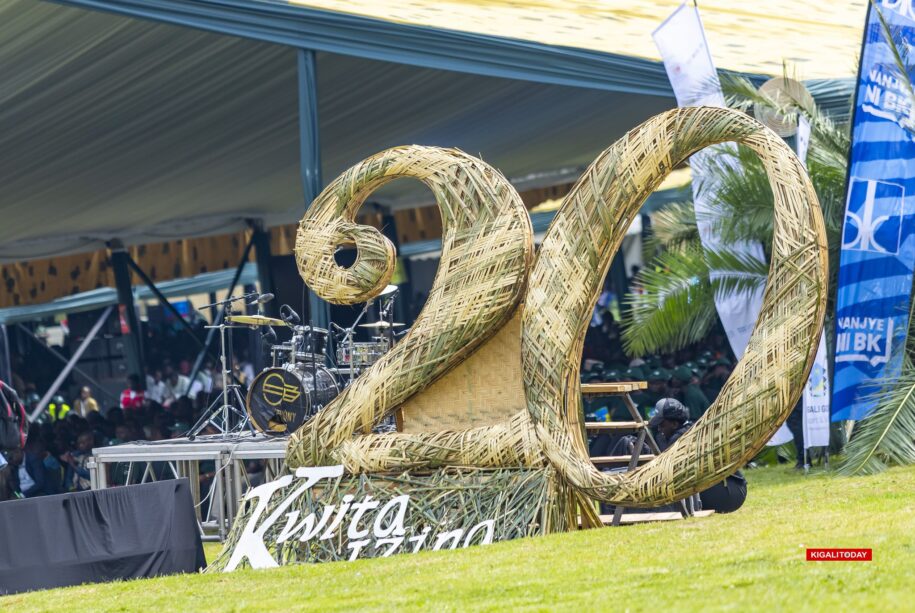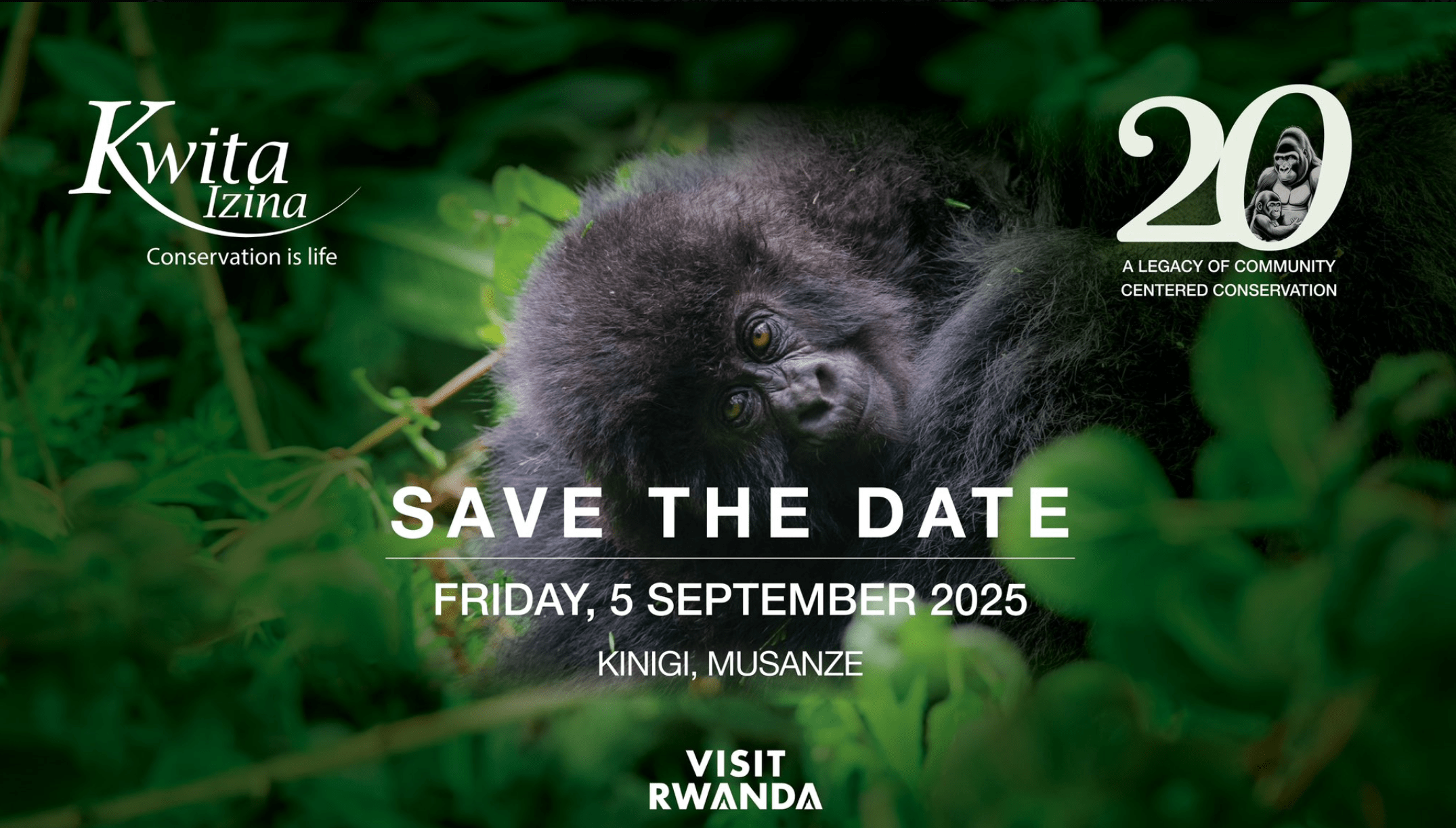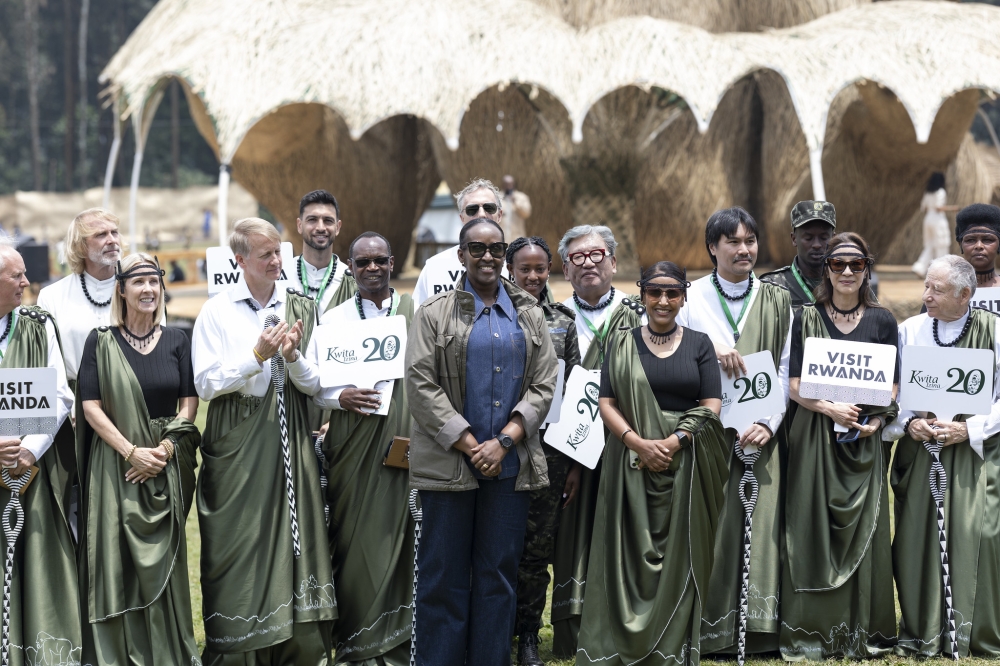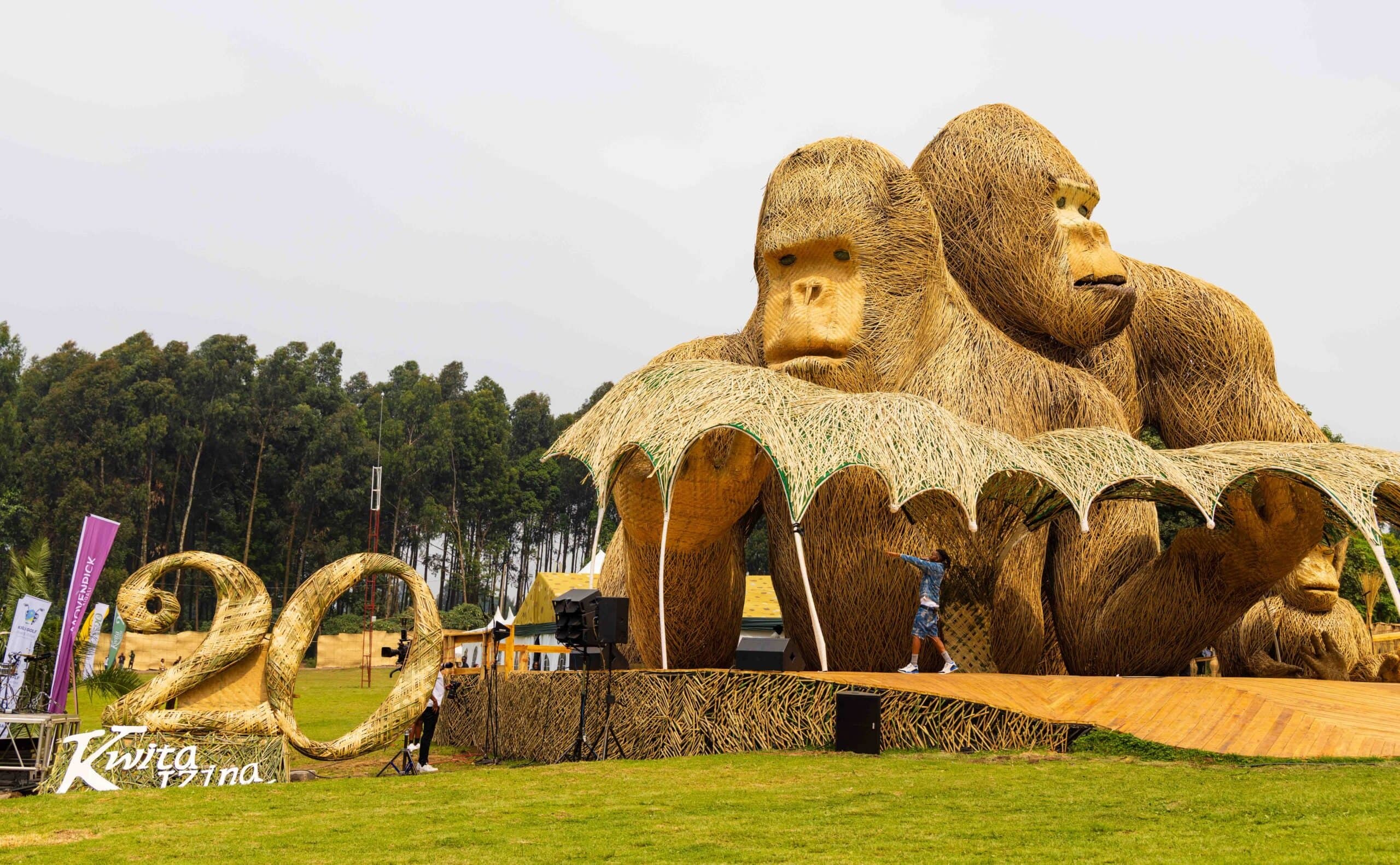Kwita Izina has evolved into one of Rwanda’s most iconic conservation events, garnering significant national and international attention each year, and Kwita Izina 2025 was no different.
Rooted in a local cultural practice originally intended to name newborns, Kwita Izina has been adapted and expanded into a global spectacle, receiving formal institutional support from the Rwandan government and conservation organizations.
The ceremony serves as a vibrant intersection of tradition, conservation strategy, and tourism diplomacy, showcasing the nation’s commitment to protecting its natural heritage.
For over two decades, 397 gorillas have been named through this event. The ceremony attracts global leaders, conservationists, local communities, and the media, further highlighting Rwanda’s strategic use of cultural symbolism to reinforce its commitment to wildlife protection.
History and Evolution of Kwita Izina
Kwita Izina 2025 draws on a centuries-old Rwandan tradition in which communities formally name newborn children in a public ceremony. In that tradition, family and neighbours gathered to bestow a name, often after symbolic actions with seeds or soil.
Before 2005, park rangers and researchers had already assigned names to infant mountain gorillas for the purpose of monitoring and tracking. This practice helped track individuals across groups and habitats, but lacked public visibility.
In 2005, the Rwanda Development Board and partners formalised the first official gorilla naming ceremony. The aim was to enhance visibility, promote community stewardship, and connect conservation to cultural identity.
Over subsequent years, Kwita Izina expanded from a small ceremony to a weeklong festival. The event now includes scientific conferences, exhibitions, community awards, and cultural performances.
In 2017, the African Wildlife Foundation published “Kwita Izina: 6 facts you need to know,” noting that the ceremony had begun naming gorillas born in the previous year under public attention.
Kwita Izina’s evolution parallels Rwanda’s success in conservation. In the early 1980s, the Virunga gorilla population consisted of approximately 242 individuals. By 2016, census counts had risen to over 600 in the Virunga region. The event’s growing scale reflects increased tourism, community engagement, and global partnerships.
Today, Kwita Izina is a central part of Rwanda’s conservation narrative. It shapes how government actors, NGOs, researchers, and local communities frame gorilla protection as both ecological and cultural responsibility.
Kwita Izina 2025 — Event Details & Highlights
a. Gorillas Named, Birth Years & Name Meanings
At Kwita Izina 2025, 40 baby mountain gorillas received official names. Among them, 18 were born in 2024, while 22 were born in 2023 (delayed naming).
Several gorilla names and their meanings were publicly reported by the “Infant gorillas receive names in historic Rwanda ceremony” article by Dian Fossey Gorilla Fund:
- Mushumba Mwiza (“Good Shepherd”) — named by Alliance Umwizerwa (a research assistant) for a baby in the Hirwa family.
- Amahitamo (“Choice”) — given by Theogene Bimenyimana for the infant of Ishyaka in Mutobo’s group.
- Atete (“To Receive Affection”) — named by Leonard Nsengiyumva for the daughter of Akariza.
- Rugwiro (“Hospitable”) — infant of mother Ubukombe, born Jan 22, 2024. ([Ibid.])
These names reflect thematic choices centered on relationships, community, trust, protection, and gratitude for conservation work.
b. Notable Namers & Stakeholder Participation
The 2025 edition featured a diverse group of global personalities, conservation leaders, and field practitioners as official “namers.” Among them:
- Dr. Gaspard Nzayisenga, Senior Field Veterinarian with Gorilla Doctors, was selected to name one gorilla. (Gorilla Doctors)
- Khaby Lame, a social media personality, performed a virtual naming role as Ogera
- Princess Ingeborg zu Schleswig-Holstein, Michael Bay, Jean Todt, Charlie Mayhew, Prof. Senait Fisseha, among others, also participated, combining celebrity voices with conservation messaging.
- Backary Sagna, former Arsenal and Manchester City footballer
Local stakeholders, including rangers, trackers, and community representatives, played a critical role as co-namers. This inclusion emphasises that naming is not only symbolic but also links conservation identities on the ground.
c. Conservation Side Initiatives & Funding Innovations
To support Volcanoes National Park’s habitat restoration, RDB (via Rwanda Nature Foundation) launched a crowdfunding platform on 6 September 2025. The platform enables individuals and organisations worldwide to contribute directly to gorilla conservation and national park restoration.
As of 2025, the Tourism Revenue Sharing (TRS) programme had invested over RWF 18 billion in more than 1,000 community projects surrounding national parks.
In alignment with this edition, an innovative green agriculture project was launched in Musanze District to support subsistence and sustainable land use among communities bordering Volcanoes.
The 2025 calendar also included:
- 29 August: Community project launch in Kinigi
- 3–14 September: Familiarisation trips for media and tour operators
- 3–4 September: Community sports and concert in Musanze
- 6 September: Golf tournament and conservation gala dinner in Kigali
These activities amplified stakeholder engagement ahead of the naming ceremony.
d. Attendance, Logistics & Security
The 20th edition drew participants from diverse backgrounds, including media representatives, tour operators, conservation organizations, government officials, and residents.
Over a thousand people reportedly gathered at the Kinigi grounds for the ceremony.
RDB and Volcanoes National Park authorities coordinated site layout, crowd control, and security.
Key elements included controlled entry points, seating sections, media zones, backstage for namers, and emergency response planning.
Given that 2025 marks two decades, the scale was higher than usual, resulting in increased demands on logistics and coordination.
Special attention was paid to ensuring that the naming platform was positioned so mother gorillas and infants would remain safe, minimise stress, and allow clear visibility to attendees (a delicate balance in primate events). Although detailed stage design is not publicly published, conservation protocols demand minimal disturbance.
Conservation Impact & Metrics
Mountain gorillas remain among the few ape species showing population growth under protection regimes.
The 2018 Virunga subpopulation census counted at least 604 individuals, up from 480 in 2010.
In Uganda’s Bwindi–Sarambwe region, the same 2018 census estimated 459 gorillas across social groups and solitary individuals.
Combined, these results pushed the total mountain gorilla count to 1,063 individuals.
Repeated surveys conducted since the early 2000s have shown steady upward trends. In Virunga, a 2003 census indicated ~380 gorillas, which later grew as conservation intensified.
The 2015–2016 survey also affirmed ~604 gorillas in the Massif, reaching an earlier projected carrying capacity threshold of ~600.
Recent reports indicate that the 2025 census will involve comprehensive genetic analysis and expanded monitoring across Rwanda, Uganda, and the DRC.
Project partners include WWF, IGCP, Gorilla Doctors, Conservation Through Public Health (CTPH), and governmental bodies.
These data validate that mountain gorilla populations are among the only great apes with confirmed increases over successive survey cycles.
Kwita Izina 2025 Role in Conservation Gains
Kwita Izina acts as a high-visibility conservation amplifier linking cultural identity to investment, monitoring, and awareness.
The ceremony helps catalyse funding pledges (e.g., through public and private sponsorships), media attention, and community engagement in buffer zones.
The 2025 edition’s crowdfunding initiative for Volcanoes National Park exemplifies this catalytic role.
By naming gorillas that are already under monitoring, Kwita Izina also promotes the bond between local communities, park authorities, and global stakeholders. That bond supports ongoing funding for patrols, veterinary interventions, and anti-snare efforts that are essential for sustaining population gains.
In addition, the reputational value of Kwita Izina helps Rwanda and its partners attract research grants, tourism interest, and institutional commitments —resources that directly support monitoring, habitat management, and community livelihoods.
Habitat, Threats, and Conservation Pressure
Population numbers alone offer partial insight. Habitat integrity, connectivity, and external threats constrain long-term viability.
Gorilla habitat is limited to the Virunga Massif and Bwindi, areas surrounded by high human density and agricultural lands.
Threats include snare injuries, disease spillover (especially respiratory pathogens), and encroachment from agriculture or settlement.
Tourist disease transmission remains a concern, addressed by strict visitor protocols.
In the Democratic Republic of Congo portion of Virunga, security conflicts, characterised by increased rebel activity, complicate park governance, reduce patrol effectiveness, and pose a risk to conservation staff and wildlife.
Climate change and associated shifts in forest composition also pose long-term stress. Changes in rainfall, plant phenology, and forest edge pressures may reduce suitable habitat or force gorilla groups to shift ranges.
Community & Stakeholder Involvement
Rwanda’s Tourism Revenue Sharing (TRS) scheme channels 10 percent of earnings from national park revenues, including gorilla permits, into community development around protected areas.
Through Kwita Izina, RDB highlights various projects, including schools, health posts, water systems, and agricultural grants, as tangible benefits of conservation.
In 2023 alone, RDB commissioned the Rukore Health Post and a potato seed collection store in park‑adjacent zones.
Local Participation in Naming and Ceremony
Local leaders, rangers, trackers, and community representatives are routinely invited to name baby gorillas and to host segments of the ceremony.
In 2025, multiple namers, including rangers from Volcanoes National Park, such as Brenda Umutoni and Jean Marie Vianney Zirimwabagabo, were involved.
This involvement reinforces symbolic ownership and links the event to those who live and work nearest the gorilla habitat.
Institutional Partnerships and NGO Roles
Non-governmental organisations play a significant role in Kwita Izina, contributing through research, logistical support, and funding.
The International Gorilla Conservation Programme (IGCP), comprising Conservation International, Fauna & Flora International, and WWF, issues announcements and supports community engagement linked to Kwita Izina.
RDB also collaborates with local conservation NGOs to design side events, such as conservation exhibitions, forums, and media familiarization tours.
Cultural & Educational Outreach
In regions around Volcanoes, schools, community groups, youth clubs, and elders participate in pre-event cultural programs tied to conservation messaging.
Kwita Izina 2025 serves as a platform for environmental education in local languages, offering lectures, performances, and exhibitions that promote the value of gorilla habitat preservation.
Institutional Recognition and Government Role
The Government of Rwanda, through RDB and the Ministry of Tourism, coordinates stakeholder roles and ensures that community benefits remain core to the event.
In 2025, Rwanda announced plans to expand Volcanoes National Park by nearly 25 percent, aiming to increase habitat capacity while ensuring that adjacent communities also benefit.
Kwita Izina 2025 featured national dignitaries; the Prime Minister, Dr. Justin Nsengiyumva, attended as the Guest of Honour.
READ ALSO: Beyond Gorillas: Rwanda’s less known Apes
Challenges, Critiques & Innovations
Balancing Population Growth with Habitat Limits
Rwanda has invested in expanding Volcanoes National Park by approximately 37 square kilometres as of 2025, aiming to accommodate the rising gorilla population.
However, this expansion entails relocating more than 3,000 households in the Musanze district. Some affected farmers argue that the replacement land is less fertile, threatening their livelihoods (especially for potato and pyrethrum farmers).
Human‑Wildlife Conflicts and Community Friction
In areas adjacent to the park, crop raiding by gorillas and wildlife intrusion create tensions.
As community expectations rise, disillusionment may grow if benefits are delayed or distributed unevenly.
There is criticism that Kwita Izina sometimes highlights symbolic gains more than day-to-day relief for rural residents.
Event Scale vs Gorilla Welfare Risks
Large attendance, media presence, and press tents can stress the environment.
Though the gorillas do not attend the public ceremony itself, disturbances around trailheads may increase noise, light, or inadvertent proximity.
Some conservationists caution that media staging or open corridors may create unintended pressure on habitat edges.
Perceptions of Symbolic Over Substance
A critique occasionally voiced in environmental journalism is that Kwita Izina 2025, while visually compelling, may foreground ceremony over long-term funding, monitoring, or enforcement.
In essence, critics question whether naming ceremonies serve as a substitute for sustained investment in anti-poaching efforts, habitat conservation, or health surveillance.
Innovations & Responses at Kwita Izina 2025
Crowdfunding Platform for Park Restoration
To enhance the impact of symbolic ceremonies with tangible funding, in 2025, Volcanoes National Park launched a global crowdfunding platform to support its restoration efforts.
This innovation allows individuals and institutions worldwide to contribute directly.
Smart Green Agriculture Pilot
In line with TRS commitments, Kwita Izina 2025 introduced a brilliant green agriculture initiative in Musanze District aimed at improving yield, soil conservation, and reducing pressure on forest margins.
This aligns community benefit with conservation goals.
Planned Park Expansion with Community Compensation
Officials have committed to fair compensation for relocated households and promised infrastructure support (roads, water, services) in their new settlements.
The government frames expansion as necessary for sustainable gorilla habitat growth.
Staged Event Design with Reduced Disturbance
For Kwita Izina 2025, authorities reportedly enhanced crowd management protocols, restricted access near habitat edges, and improved media staging zones to minimize the impact of light and noise.
Although a detailed staging layout has not been published, conservation bodies emphasize that the naming platform remains physically distant from gorilla families.




